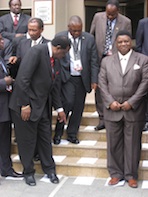Saturday, April 20, 2024
News and Views from the Global South
SOUTHERN AFRICA: Non-Tariff Trade Barriers Springing Up
Servaas van den Bosch
- Despite regional initiatives that even include the eventual possibility of a ‘‘Cape- to-Cairo’’ free trade area, protectionist impulses have caused non-tariff barriers to spring up across Southern Africa.

SADC trade ministers lining up for a photo opportunity after the Mar 4, 2011 meeting. Namibian trade minister Hage Geingob is pointing to the ground. Credit: Servaas van den Bosch/IPS
However, there has been little progress in shaping the predominantly political alliance into an economic bloc and non-tariff barriers have become a serious concern. A SADC FTA has theoretically been in place since 2008, but hasn’t brought the free movement of people and goods it was meant to.
“We work successfully with governments to remove non-tariff barriers, for instance at border posts — only to see them being put up again six months down the line,” lamented Gilbert Boois, manager of projects and funding at the Walvis Bay Corridor Group.
The group promotes trade between landlocked countries in the region and the Atlantic Ocean port of Walvis Bay in Namibia.
Zambian trade consultant John Kasanga cites countless examples of non-tariff barriers across the region: “Zambia protects its sugar industry from cheaper imports from Zimbabwe by demanding that all imported sugar be fortified with vitamin A.
“Zimbabwe, in turn, has blocked Zambian strawberries by stipulating that any shipment of this fragile fresh produce must be at least a massive one ton.”
All over the region countries are moving to protect sensitive industries, like the dairy sector, by banning imports from neighbours. Trucks can spend weeks at border posts to comply with costly and time-consuming customs procedures. And many countries are behind in harmonisation of regional standards.
“Some members of the SADC FTA are not coming forward and don’t participate in the (SADC trade) protocol. They are not working towards regional integration,” director of international trade in the Namibian ministry of trade and industry Annascy Mwanyangapo summed up.
The problems led to an indefinite postponement of the SADC customs union initially scheduled for 2010.
“A ministerial taskforce is looking into the issue of the (SADC) customs union and will make a recommendation on the way forward before the end of 2011,” was the elusive answer of SADC’s executive secretary, Tomás Salomão, when asked about the fate of the customs union.
“We cannot continue to pay lip-service to these things,” commented SADC council chairperson and Namibian trade minister Hage Geingob after the Mar 4 meeting, adding that he is ‘‘worried’’ about ‘‘the slow pace of implementation’’ within SADC.
“Business people and citizens should move freely throughout the region. We cannot keep talking about jobs being taken by other Africans. Rather, we should see such movement as ‘brain circulation’,” argued Geingob.
Meanwhile, the main building block of the coveted SADC customs union, SACU, is crumbling as South Africa remains embroiled in a fierce battle over customs and excise revenue with its smaller neighbours Botswana, Lesotho, Namibia and Swaziland (BLNS).
At its heart, the disagreement signals a wider rift between, on the one hand, Pretoria’s quest for market expansion and, on the other, the development objectives of its much poorer cousins in SACU.
Enlarging SACU now would only deepen this divide, say observers, casting doubt on SACU’s role as a cornerstone for a SADC customs union.
“States will have to decide. Are they going to join a South Africa-dominated customs union or are they going their own way?” asked Geingob with regard to SACU’s future role. “Right now we are talking about the modalities, what is working and what is not.”
“Using the principle of variable geometry, countries could join a customs union whenever they are ready,” offered Salomão. “Maybe we start from scratch, or maybe a SADC customs union should start with the SACU-Five and later on countries can join one by one.”
Slow as progress is on a SADC customs union, a sense of urgency surrounds the establishment of a tripartite free trade area (FTA) between SADC and two other major regional economic communities (RECs) – the Common Market for Eastern and Southern Africa (COMESA) and the East African Community (EAC).
At stake is a tripartite FTA that includes 26 countries, 527 million consumers and a combined gross domestic product of 624 billion dollars. The FTA would represent over half of the continent’s wealth and population. “If this FTA is in place we’ll have a free trade area from Cape to Cairo,’’ enthused Geingob.
Countries will likely reach an agreement on a tripartite FTA during a mid- 2011 summit in South Africa.
The trade ministers present in Windhoek saw ‘‘no contradiction’’ between working towards for a SADC customs union and expanding the free trade area, but the hurry in establishing the pan-African FTA is no coincidence.
While it needs SACU’s common external tariff (CET) to protect its automotive and electronics industries, a wider SADC customs union is an unnecessary burden on Pretoria’s treasury.
The pan-African FTA, on the other hand, would ease market access for South African goods and services and solidify its position as a gateway to the continent through South-South alliances like IBSA (India-Brazil-South Africa) and BRICSA (Brazil-Russia-India-China-South Africa).
“The tripartite FTA has moved to the front of the agenda,” says an international trade negotiator who prefers not to be named due to the sensitivity of the issue.
“It doesn’t mean the SADC customs union is completely off the cards, but the South Africans will not join if there is nothing in it for them.”

 Print
Print



